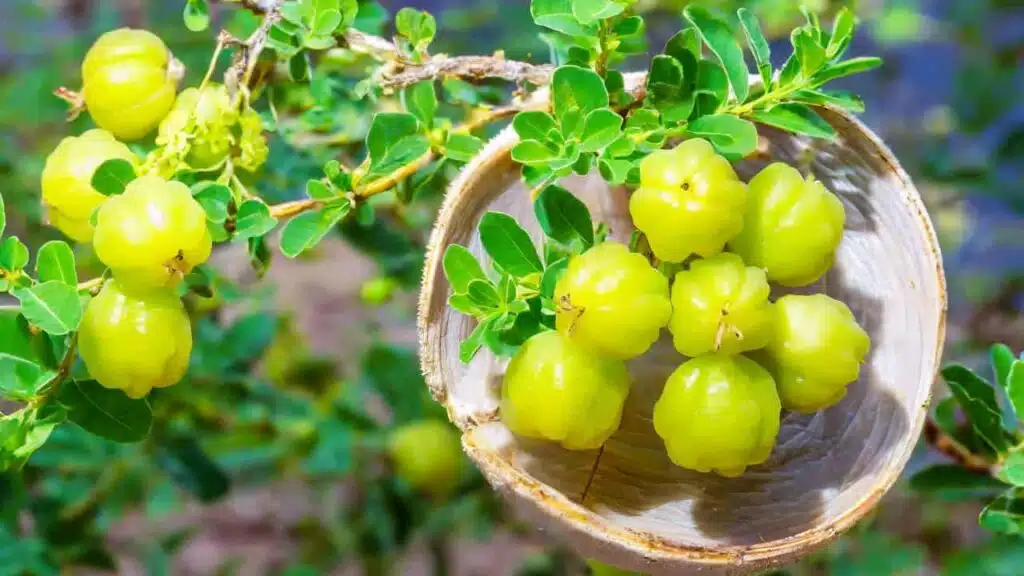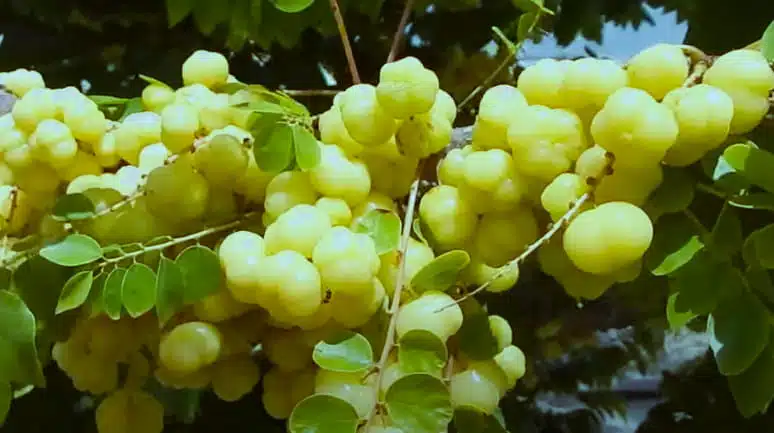Grosella fruit, also known as Phyllanthus acidus, star gooseberry or Malay gooseberry, is a tree that bears small yellow berries. Despite its name, the fruit does not resemble a gooseberry except for its tart and sour taste. In this article, We will delve into the Introduction, origin, cultivation, nutritional and culinary uses, and the medicinal and other uses of this fascinating fruit.
| Common Name | Grosella Fruit |
| Scientific Name | Phyllanthus acidus |
| Family | Phyllanthaceae |
| Plant Type | Tropical Tree |
| Mature Size | 15-25 feet |
| Sun Exposure | Full Sun |
| Soil Type | Well-draining |
| Soil pH | Slightly acidic |
| Bloom Time | Spring to Summer |
| Flower Color | Greenish-yellow |
| Temperature | Warm to Hot |
| Hardiness Zones | 10-11 |
| Native Areas | Southeast Asia |
Table of Contents
Introduction
Grosella fruta is an intermediary between a shrub and a tree, reaching a height of 6 to 30 ft. The tree has a dense, bushy crown of thickish, tough main branches. The flowers of this plant can be male, female, or hermaphrodite, and they appear in clusters in long panicles. The fruit itself is oblate, pale yellow or white, waxy, crisp, and very sour. Each fruit contains 4 to 6 seeds in a stone at its centre. Originating from Southeast Asia, Grosella has become a global favourite due to its unique flavour profile and nutritional richness. it is cultivated and found in various countries such as India, Thailand, Brazil, Puerto Rico, and the United States.
How to Grow Grosella Fruit Plant

- Selecting the right climate to suit plant preferences.
- Preparing the planting site with well-draining soil and ideal sunlight.
- Plant them in pots or directly on the ground. For seedlings, transplant them carefully, ensuring the root system is intact.
- During the growing season, apply a balanced fertiliser to provide essential nutrients.
- Remove dead or diseased branches and trim for overall plant health.
- Check everyday temperature and humidity levels, especially in regions with varying climates.
- Regularly inspect the plant for pests such as aphids or caterpillars.
- Monitor the fruit for ripeness, typically indicated by colour changes and slightly soft texture.
Grosella Fruit Plant Care:
Grosella fruit, scientifically known as Phyllanthus acidus, is a healthy plant that requires a delicate balance of attention and care, from providing the ideal sunlight exposure to selecting the perfect soil composition.
Sunlight
Grosella plants require a lot of sunlight for their growth and fruiting. With a preference for tropical climates, Grosella plants grow exposed to a minimum of 6 to 8 hours of direct sunlight daily. Its impact on plant metabolism, and how to provide the optimal light conditions for your Grosella fruit plant. Sufficient sunshine promotes photosynthesis and adds to the general health and yield of the plant.
Soil
Grosella plant care lies in selecting the right soil. Optimal growth and fruit development occur in well-draining, slightly acidic soil enriched with organic matter. Soil composition and structure are vital for promoting healthy root development, nutrient absorption, and overall plant vitality.
Water
Grosella plant health is highly dependent on proper watering procedures. However, overwatering can lead to root rot, so finding the right balance is crucial. Mulching around the base of the plant helps retain soil moisture.
Pruning
Pruning is a skill that significantly influences the shape, size, and productivity of Grosella plants. Remove dead or diseased branches, shaping the plant for improved air circulation, and promoting sunlight penetration. During the growing season, apply a balanced, slow-release fertilizer to provide essential nutrients for the tree’s development and fruiting.
Mulching
Mulching has advantages that go beyond appearance; it is essential to the general health of Grosella plants. The benefits of mulching as soil temperature control, weed reduction, and moisture retention.
Propagating Grosella Fruit Plant

Seed Propagation
- Choose fresh, high-quality seeds from mature Grosella fruits.
- Clean seeds thoroughly, making sure to get rid of any pulp or debris.
- Increase seed germination by soaking them in water for a full day.
- Plant seeds in a well-draining mix at a depth of 1/4 to 1/2 inch.
- Keep soil consistently moist for germination, taking two to four weeks.
- Transplant seedlings to larger containers or the garden after are leaves develop.
Cutting Propagation
- For cuttings, select branches with three to four joints that are disease-free and in good health.
- Remove leaves from the lower portion of the cutting.
- Dip the cut end in rooting hormone to encourage root development.
- Plant the cutting in a well-draining potting mix, burying at least one node.
- Keep soil consistently moist and place the cutting in a shaded area.
- Over a few weeks, roots will grow and indicate that the plant is ready for transplanting.
General Care for Propagated Plants
- Provide consistent moisture during the initial stages of propagation.
- Protect young plants from harsh sunlight to reduce stress.
- Keep an eye out for pests or diseases and address them promptly.
- As propagated Grosella plants mature, continue care similar to established plants.
Pests and Diseases
Pests and diseases can attack even the hardiest plants. Pests, ranging from aphids to scale insects, can hinder growth, while diseases such as fungal infections may compromise overall plant health. Prevention stands as the first line of defence against pests and diseases. It is essential for growers to regularly check Grosella plants for changes in the leaves, discolouration, or symptoms of distress.
Grosella Fruit Plant Benefits
Grosella fruit is a wonderful fruit with many nutritional and health benefits. Rich content of vitamin C, antioxidants, and other essential compounds. Moreover, the Grosella fruit plant is known to be a source of dietary fibre, which is essential for digestive health. Adequate fibre intake supports smooth digestion, helps prevent constipation, and contributes to a healthy gut microbiome.
Culinary Uses of Grosella Fruit
The tangy and sweet characteristics of grosella fruta add a refreshing burst of flavour. When the fruit is added to sorbets, jams, or pies, it adds a unique flavour that goes well with a variety of sweet treats. Because of its vibrant flavour, it also adds a delicious contrast to fruit salads, which improves the overall mouthfeel.
In beverages, Grosella fruit takes centre stage, offering a refreshing twist to cocktails, mocktails, and fruit-infused waters. Its bright and tangy essence adds complexity to beverages, making them a delight for the senses.
Beyond the obvious, Grosella finds its place in condiments and chutneys, where its unique flavour becomes a focal point. We can add it to salsas or relishes to provide a burst of flavour that goes well with a variety of dishes.
Common Problems with Star Gooseberry(Grosella)
- Check the leaves frequently for indications of pests like mites, caterpillars, or aphids.
- Natural predators like ladybugs use neem oil as an organic deterrent.
- If an infestation is persistent, consider using a moderate insecticidal soap and pruning the afflicted areas.
- Watch for symptoms like wilting, discolouration, or unusual spots on leaves.
- Provide shade during peak sunlight hours and use mulch to regulate soil temperature.
- Yellowing between leaf veins or poor nutrient absorption.
- Based on the findings of soil tests, adjust pH imbalances with additives such as sulphur or lime.
- Prune excess growth, promoting better air circulation and minimizing the risk of diseases.
conclusion
In conclusion, Grosella fruit, also known as Star Gooseberry or Malay Gooseberry, stands as a fascinating tropical delight with a distinctive flavour profile. Originating from Southeast Asia, this tree boasts not only culinary versatility but also a range of health benefits. From its unique cultivation requirements to propagation techniques, Grosella offers a wonderful excursion into the world of tropical fruit cultivation. Whether enjoyed fresh, incorporated into various dishes, or utilized for its medicinal properties, Grosella remains a cherished addition to gardens and palates globe.
How do I grow Grosella fruit plants?
Select the right climate, use well-draining soil, provide full sun exposure, and maintain a balanced fertilizer regimen. Regular pruning and monitoring for pests contribute to successful cultivation.
What are the health benefits of Grosella fruit?
Grosella is rich in vitamin C, antioxidants, and dietary fibre. It supports digestive health, contributes to a healthy gut microbiome, and provides essential nutrients for overall well-being.
How long does it take for Grosella plants to bear fruit?
Grosella plants typically start bearing fruit within 2-3 years of planting. However, factors such as climate, soil quality, and care practices can influence the time of the first harvest.
Is it possible to grow Grosella fruit indoors?
While Grosella plants prefer full sun, you can grow them indoors with ideal sunlight. Use containers with well-draining soil, and ensure proper pruning to manage size in confined spaces.
